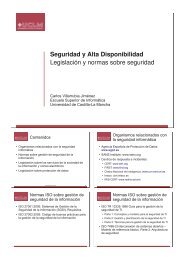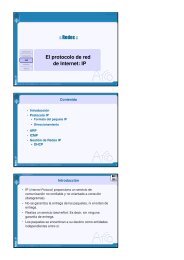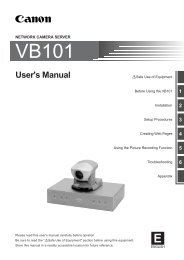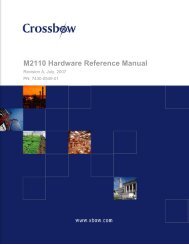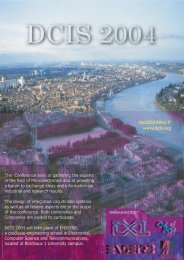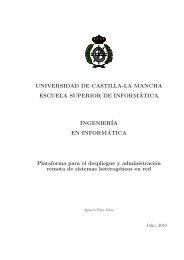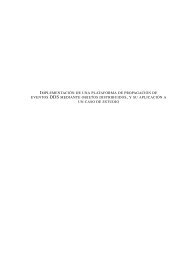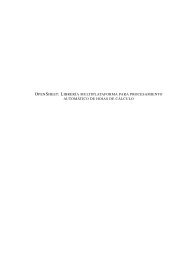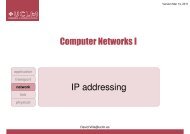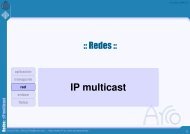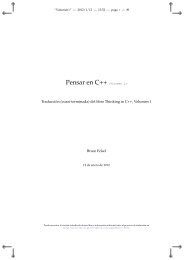true.Additionally, the meaning of these propositions is unavoidably associated to the context in whichthey are being consi<strong>de</strong>red. In this sense, meaning is expected to be something more elaborate thanjust mere conventions about what other concepts state their significance to be. On the contrary, themeaning associated with a proposition has to be given in terms of how it affects the context. Aplausible way of doing so is by means of the “possible world” theory. As stated in [112] there are twopossible ways of <strong>de</strong>scribing what a possible world is. On the one hand it can be <strong>de</strong>scribed as a set ofconsistent propositions that are true in a given world. On the other hand, a possible world can also beexplained as an account for how things can be interpreted in a given world. The same author statesthe following, regarding the existing relation between context and possible worlds:“ contexts are possible worlds in which judgments are <strong>de</strong>rived, so that each judgmentstated true by the theory is true in a certain world, namely the one providing all theinformational data nee<strong>de</strong>d in or<strong>de</strong>r to acquire the knowledge contained in that judgment(i.e. the information which expresses the conditions to verify the propositional content ofthe given judgment). This world is namely expressed by a context 1 .”Later on this chapter, in Section 4.5 there is a <strong>de</strong>scription of how possible worlds can be formalizedby means of the Kripke structures.4.3 The context syntaxAfter having reviewed the state of the art for context mo<strong>de</strong>ling, this and the following sections are <strong>de</strong>votedto <strong>de</strong>scribing the insights of the proposed strategy for mo<strong>de</strong>ling Ambient Intelligence contexts.To this end and, inspired in the three-dimensional view of the context notion advocated by Sowa, the<strong>de</strong>scription of the proposed mo<strong>de</strong>ling approach is organized in terms of the dimensions previously<strong>de</strong>scribed.Consequently, this section concerns capturing the context syntax, and to this end, the lexicon ofthe proposed context mo<strong>de</strong>l has to be provi<strong>de</strong>d, along with the rules that <strong>de</strong>termine how these symbolscan be combined, by means of a context-free grammar.The i<strong>de</strong>ntification of the context lexicon starts by establishing all the categories or entities comprisingthe vocabulary of the proposed language. The revision of some of the most successful andwi<strong>de</strong>ly accepted categories for context-aware systems, such as the ones proposed by Ryan in [122],Schilit in [128], or Dey and Abowd in [1], leads to the conclusion that <strong>de</strong>spite being right in theinsights, the proposed categories fail to comply with the requirement of low-coupling between thedifferent context dimensions. Whereas categories such as location and time are part of the lexicon,some others such as activity or i<strong>de</strong>ntity escape from the syntax dimension and should be part of thesemantic one. However, this poses a question; the i<strong>de</strong>ntification of what should be part of the lexiconand what should be kept outsi<strong>de</strong> it? For the sake of preserving the in<strong>de</strong>pen<strong>de</strong>nce of the three contextdimensions the proposed approach adopts the convention of consi<strong>de</strong>ring that just the informationdirectly extracted or related to sensors should be consi<strong>de</strong>red part of the lexicon.The fact that Ambient Intelligence systems are fed with raw information, directly gathered fromsensors, simplifies the vocabulary lexicon nee<strong>de</strong>d to <strong>de</strong>scribe such contexts. In contrast to whatmight happen in Natural Language Processing, in which the consi<strong>de</strong>red vocabulary must be the wholelanguage itself, in Ambient Intelligence, vocabulary is limited to those items that handle actions an<strong>de</strong>vents and those that contain the sensed environmental data.1 PRIMIERO, G., Information and Knowledge. A constructive Type-theoretical Approach.Logic, Epistemology, and theUnity of Science, Vol. 10. ISBN 78-1-4020-6169-1, pp. 15258
The context syntax is inten<strong>de</strong>d to strictly enumerate the domain concepts that are consi<strong>de</strong>red inthe mo<strong>de</strong>led context. High level knowledge is therefore left for the upper dimensions (semanticsand pragmatics), preserving the low-coupling requirement between this and the remaining contextdimensions. The main advantage of achieving a non-coupling mo<strong>de</strong>l is to do with the benefits ofaddressing each dimension with the mo<strong>de</strong>ling approach that best fits the features of each dimension.Regarding the syntactic dimension, the mo<strong>de</strong>led approach basically consists in <strong>de</strong>scribing thesymbols and the rules that <strong>de</strong>termine how these symbols can be combined. Despite the fact that OWLor OWL-DL have traditionally been chosen for mo<strong>de</strong>ling the context syntax, more basic and efficientmechanisms can also be used to cope with the task of capturing and mo<strong>de</strong>ling the syntactic dimension.Recall Sowa’s <strong>de</strong>finition of the syntactic dimension which only ascribes to it the responsibility forenumerating the symbols that are required for expressing knowledge about contexts, along with therules that <strong>de</strong>termine how those symbols can be combined. At this level nothing has to be said aboutthe meaning of those symbols or their relationships. These are the responsibility of the upper contextdimensions, and therefore, they will be addressed in the following sections.Similarly to how lexicon of formal languages is established and bearing in mind both the need forsimplicity and efficiency restrictions, the proposed approach for mo<strong>de</strong>ling the syntactic dimension ofcontext follows the theory of formal language.Using the notation and <strong>de</strong>finitions of this theory, a context-free grammar is postulated as a meansof capturing the context syntax. The following <strong>de</strong>finitions present the foundations of a formal languagefor mo<strong>de</strong>ling Ambient Intelligence contexts.Definition 1: A context-free grammar is <strong>de</strong>fined as a four-tuple, such that:G = (B,E,Γ,S 0 ) (4.1)where:S 0 : is the initial axiom or symbol.B: is the alphabet or lexicon. It is also known as the set of terminal vocabulary of the grammar.E: is the set of non-terminal symbols of the grammar.Γ: is the set of production rules, such that:Γ : E → X 1 ,...,X n where X i ∈ (B ∪E) ∗ (4.2)Definition 2: L is the language such that L = L(G), whose grammar G = (B,E,Γ,S 0 ) is <strong>de</strong>finedas follows:E = {S 0 , Definition, Predicate, Statement, Type, Device-id, Service-ID,Action-ID, Object-ID, Event-ID, Place-ID, Time-ID}B ={event, action, <strong>de</strong>vice, service, object, place, value, time, provi<strong>de</strong>s,performs, at, in, upon, has-value, is-a, causes, i<strong>de</strong>ntifier }Γ = {(1) S 0 → Predicate in-context C(2) Predicate → Definition | Statement(3) Definition → i<strong>de</strong>ntifier is-a Type(4) Statement → i<strong>de</strong>ntifier has-value value(5) Statement → Device-ID provi<strong>de</strong>s Service-ID59
- Page 1:
DEPARTAMENTO DE TECNOLOGÍAS Y SIST
- Page 4 and 5:
María José Santofimia RomeroTelé
- Page 7:
ResumenLa Inteligencia Ambiental, p
- Page 11 and 12:
ContentsContentsList of TablesList
- Page 13:
CONTENTSVII7.4.4 The Plan Executor
- Page 17:
List of Figures4.1 Kripke model for
- Page 21:
Part IPreliminaries3
- Page 24 and 25:
This gap poses an urgent need to de
- Page 26 and 27: and events, and the mechanisms to r
- Page 28 and 29: Maria’s ankle as an impediment to
- Page 30 and 31: 1.3 Aims and objectivesGiven that t
- Page 32 and 33: The fourth item concerns the way th
- Page 34 and 35: of such goals and desires and how t
- Page 36 and 37: tion, is addressed by coping with a
- Page 38 and 39: networking from being widely spread
- Page 40 and 41: The MERL’s Ambient Intelligence f
- Page 42 and 43: tions come into play. These scenari
- Page 44 and 45: interact with electronic devices, e
- Page 46 and 47: tionally, the middleware architectu
- Page 48 and 49: The idea behind the work proposed h
- Page 50 and 51: esources under a middleware based o
- Page 53: Part IIUnderstanding35
- Page 56 and 57: obvious. In this sense, sociologist
- Page 58 and 59: true throughout a time interval, or
- Page 60 and 61: application domain is (true, false)
- Page 62 and 63: (SubAsbstrac Nathan Nathan2007)(Sub
- Page 64 and 65: Moreover, events not only cannot be
- Page 66 and 67: epresented by means of the notion o
- Page 68 and 69: Context-awareness is one of the mai
- Page 70 and 71: In any case, the adopted behavioral
- Page 72 and 73: when the water level starts increas
- Page 74 and 75: Traditionally, these responses have
- Page 78 and 79: (6) Statement → Service-ID perfor
- Page 80 and 81: the set of possible contexts, and M
- Page 82 and 83: in which S is a nonempty set of sta
- Page 84 and 85: are considered possible given the p
- Page 86 and 87: cope with the demands involved in d
- Page 89 and 90: Chapter 5Understanding Context Situ
- Page 91 and 92: Figure 5.1: Overall view of the pro
- Page 93 and 94: adjusting existing knowledge to sim
- Page 95 and 96: of some events involves the stateme
- Page 97 and 98: ( new-statement { picker } {is loca
- Page 99 and 100: The way of determining which after
- Page 101 and 102: CL-USER > ( the-x-of-y-is-z { enter
- Page 103 and 104: CL-USER > ( the-only-x-of-y-is-z {
- Page 105 and 106: CL-USER > ( get-element-fluent ( lo
- Page 107 and 108: The specificity of the propositiona
- Page 109 and 110: Following the same dynamic, the dif
- Page 111: part is intended to propose a solut
- Page 115 and 116: Chapter 6Behavioral Response Genera
- Page 117 and 118: and action selection by means of a
- Page 119 and 120: wants the room to be at a higher te
- Page 121 and 122: state of the world with those plann
- Page 123 and 124: conflict. The later strategy requir
- Page 125 and 126: Function f returns the actions, fro
- Page 127:
next step selected in the plan. The
- Page 130 and 131:
of it. It is also possible to try t
- Page 132 and 133:
Agent System (MAS), individual agen
- Page 134 and 135:
the requirements stated for the BRG
- Page 136 and 137:
The action planning algorithmMaking
- Page 138 and 139:
The advantages underlying service c
- Page 140 and 141:
effects. On the contrary, an approp
- Page 143:
Part IVValidation and discussions12
- Page 146 and 147:
taking place. The interpretation of
- Page 148 and 149:
The key elements of the evaluation
- Page 150 and 151:
also been proved to serve as a mean
- Page 152 and 153:
Table 8.2: Simulation Configuration
- Page 154 and 155:
the knowledge-base, it saves time i
- Page 156 and 157:
effects and the sensed ones leads t
- Page 158 and 159:
Table 8.3: Personal information of
- Page 160 and 161:
Scenario Interpretations Number of
- Page 162 and 163:
understand the terms used to descri
- Page 164 and 165:
Finally, the causal explanation app
- Page 166 and 167:
2. A2: To provide a service composi
- Page 168 and 169:
System has to be motivated by goals
- Page 170 and 171:
een addressed by this thesis. Howev
- Page 173 and 174:
Bibliography[1] Gregory D. Abowd, A
- Page 175 and 176:
[25] Diane J. Cook, Juan C. Augusto
- Page 177 and 178:
[54] Tao Gu, Hung Keng Pung, and Da
- Page 179 and 180:
[83] Clemens Lombriser, Nagendra B.
- Page 181 and 182:
[110] Davy Preuveneers, Jan Van den
- Page 183 and 184:
[134] John F. Sowa. Conceptual Stru
- Page 185:
Part VIAppendix167
- Page 188 and 189:
Ambient Intelligence environment, i
- Page 190 and 191:
invocation. However, in reality the
- Page 192 and 193:
consists in querying the Topic Mana
- Page 194 and 195:
Figure A.4: Multi-Agent System over
- Page 196 and 197:
The result of the planning algorith
- Page 198 and 199:
concepts and relationships are impl
- Page 200 and 201:
As listed below, the recognition ac
- Page 202 and 203:
184Figure A.8: Sequence diagram for
- Page 204 and 205:
}query = " ( b−wire ( car ( list
- Page 207:
Este documento fue editado con GNU



